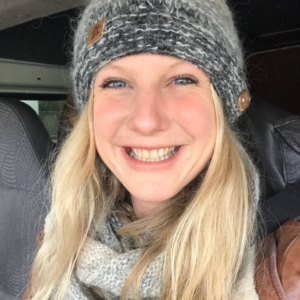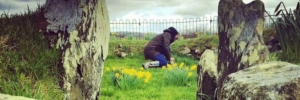 Katie Newton was inspired to explore the Island’s keeill sites after a presentation on them by Andy Johnson of Manx National Heritage. With her friend, Nicola Curphey, Katie set out on an unofficial project to visit a variety of sites. Many of them are on private property, so she and Nicola had to get permission to visit them. Their visits were fuelled by home-made cakes which they were able to sit and enjoy after locating the chosen keeill, or, in some cases, keeill site, with very little remaining to show that a keeill had been there. Some were very overgrown with bushes and trees; others were little more than small mounds in the landscape; but many of them showed the remains of their low, stone-built walls with door and window openings, and often in quiet and beautiful settings throughout the Island.
Katie Newton was inspired to explore the Island’s keeill sites after a presentation on them by Andy Johnson of Manx National Heritage. With her friend, Nicola Curphey, Katie set out on an unofficial project to visit a variety of sites. Many of them are on private property, so she and Nicola had to get permission to visit them. Their visits were fuelled by home-made cakes which they were able to sit and enjoy after locating the chosen keeill, or, in some cases, keeill site, with very little remaining to show that a keeill had been there. Some were very overgrown with bushes and trees; others were little more than small mounds in the landscape; but many of them showed the remains of their low, stone-built walls with door and window openings, and often in quiet and beautiful settings throughout the Island.
In some cases, incoming tenants hadn’t realised that there was a keeill site on the property. There was concern that this might lead to what had been deliberate policy elsewhere, with sites being ploughed over or cattle allowed to trample down what remained. However, Katie showed us one site where the incoming tenants had looked forward to seeing the keeill site which was marked on the maps, only to be disappointed that the remains of the keeill had been erased, and all that was left to show the site was a stone that had been put in to show its location.
Many of the photographs Katie showed were by Nicola Curphey. She contrasted some of these with images from the reports of the Manx Archaeological Survey. It seems the surveyors were in the habit of ‘restoring’ some of the sites they visited.
As so many of the sites are not normally accessible to the public, it gave us an opportunity to see places that we hadn’t had the opportunity to visit for ourselves and learn more about them from the photographs and information that Katie shared with us in her very enjoyable presentation.

